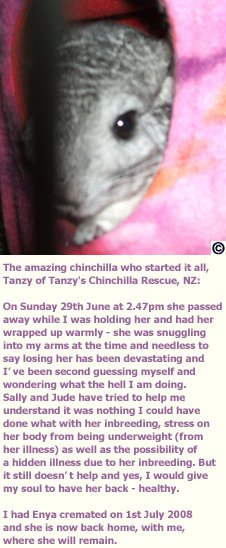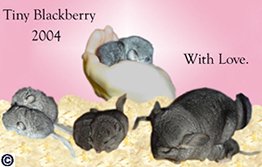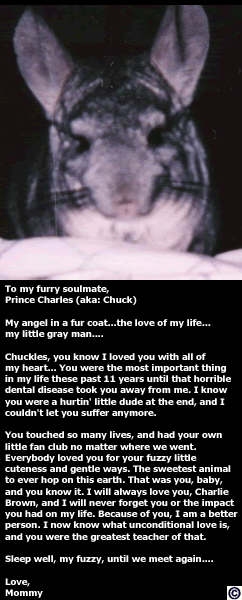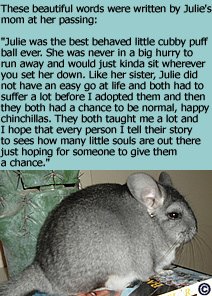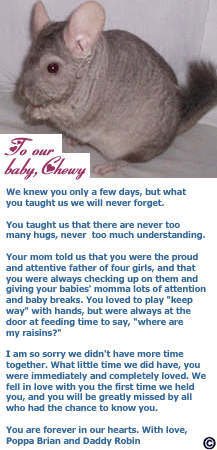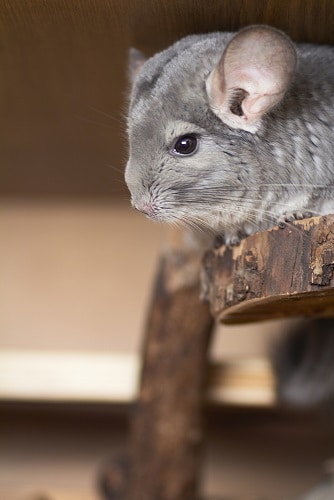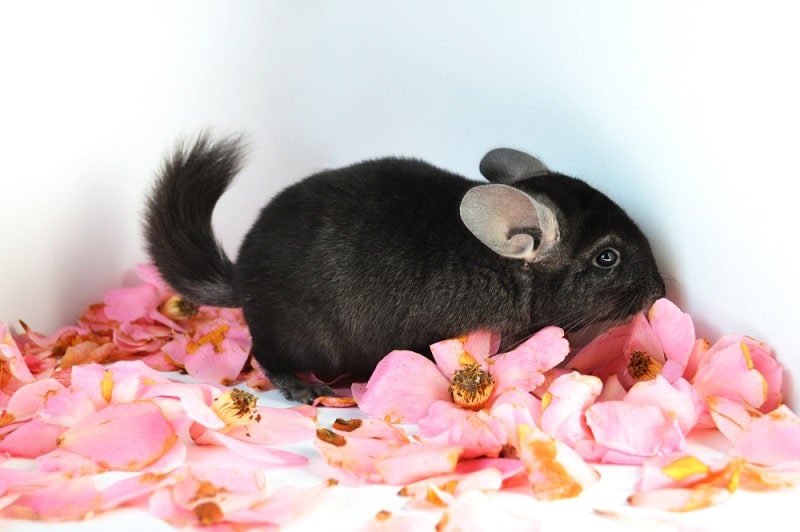
Chinchilla Memorial And Support Sites, Burial Wares
- ASPCA Memorial Page
- Assoc for Pet Loss and Bereavement
- Cheeky Chinchillas- How It Began
- Chinchilla’s Memorial Column
- Eden Publications LLC: Pet Loss Resources
- Irene’s Chinchillas: Chins In Heaven
- Pet Loss and Grief Support
- Pet Loss, Grief Support Site
- Remember Our Pets
- Texas Chinchilla Memorial Page
- Virtual Pet Cemetery
Please take a moment to view these images, memorials to a few of our site reader’s beloved angel chins:
Memorial projects such as this cross-stitch offer an opportunity to work through the grieving process and make a tribute to your loved one. If your chinchilla has passed over into that great Andes mountain range in the sky and you’d like to send us their picture with a few commemorating words, we’ll post it in the Memorial Sites section of this page, per the colored box above.
The Message In Memorials
Take time to read the dedications that relate tragedies, those deaths aren’t in vain as long as they can serve as a forewarning to others, to keep our beloved chinnies safe. These sad stories serve to remind of such things as the importance of shuffling feet when chins are running underfoot, chin-proofing prior to supervised exercise time, and the necessity of reviewing the “Checklist” and “Factors to Consider” when planning to neuter.
Estate Planning: Prevent Orphaned Pets!
Yes, it’s a morbid thought, but it’s also practical and realistic to make preparations while we CAN to secure our pet’s future in the event of untimely demise. Pets whose owners die suddenly have been known to suffer neglect, abuse, to become subjects for vivisectional research, or end up dumped at kill shelters because the surviving relations aren’t prepared or willing to continue providing quality care for these orphaned pets.
That is why estate planning should be a matter of urgent necessity to every devoted, conscientious chinparent. It’s the only way to help ensure that these precious lives that are so totally dependent on us will continue to be lovingly cared for when we’re gone.
In a word, YES. Chinchillas are social animals, in the wild they travel in groups, or “herds.” Most prefer companionship, the company of their own kind. We advise same-sex pairs, it’s the easiest way to meet their need for social contact without involving reproduction. Shortly after the remains have been put to rest, start looking for another cagemate for the surviving chinchilla. Chinchillas can become very stressed and anxious, or depressed and withdrawn, after the death of their cagemate and this can directly affect their appetite, general outlook and will to live.
In fact, in the period immediately following a death, it’s good to provide the bereaved with a stuffed animal, just so they’ll have something they can sit beside that’s soft and cuddly. Ensure that the stuffed animal has no tags, whiskers, strings (they can be cut off), or other loose pieces that the chinchilla could nibble off and swallow. Having a stuffed animal to cuddle with can be as consoling for chins as it is for children.
We, the ChinCare webmasters, have experienced our share of deaths over the years and it has always seemed that the ones who got to be there when their cagemate or partner passed, or at least got to sniff over the body later, we’re better able to accept the situation and move on without excessive grief, stress and sulking. We spoke with our exotics specialist vet about this once and she concurred that it is important they see for themselves and acknowledge the fact that death has occurred. Unless they see the body, they can’t acknowledge the death and their grief is compounded with the stress of having someone close to them just, “disappear.”
From personal example, we had one boy pass suddenly on the way to the vet’s, even the autopsy we ordered was vague about cause of death and he was cremated after the autopsy. His mate (Njal was a neutered male), Fresca, never got to acknowledge his death, to her his fate was unknown and as a result she spent the next few weeks sitting in the cage corners- sulking, listless, and defensive when approached.
It was as if she suspected that there may be some imminent danger to her own well-being, or perhaps she was just protecting their territory until Njal could return. We believe that if Fresca had the opportunity to see the body and acknowledge his death when it transpired, her grieving process would have been completed and put behind her that much sooner.
Death Throes: A Chin’s Final Moments
Sometimes we’re there when our beloved chin passes over the rainbow bridge, sometimes not. The most important thing to bear in mind when we are there and our chin is in his very last moments is that this is HIS time, and our attention and efforts should be focused on comforting him and easing his departure, not on our own grief. To clarify, this article is about a chin’s VERY final moments, what it looks like when death is imminent and nothing can bring him back. If there is ANY chance that the chin could benefit from the immediate attention of an exotics specialist vet, he should be rushed to an emergency veterinary clinic without delay.
The best predictor of whether a chin may be in decline is knowlege of a pre-existing condition, i.e., if he’s old, has suffered illness or injury, has experienced an abrupt, major change that could have caused acute shock (not a common problem, but it can happen), etc. Signs of decline include: seeking lower levels of the cage, general apathy and unwillingness to move, acting weak or wobbly, but take note that these signs when taken out of context can indicate a myriad of other conditions, including mere sleepiness.
Chinchillas can “wind down” very quickly, much like a wind-up doll that’s slowing down before it stops. They do seem to realize when this is occurring, sometimes it’s as if they’ve resigned themselves, but they may look surprised and frightened. The very final moments are at hand when the chief symptom manifests itself: the chin is gasping for air through his mouth. Chins normally breathe through their nose, when they’re breathing through their mouth it’s a desperate attempt to take in air, the veterinary designation for this is “agonized breathing” and the chin may even paw at his mouth a few times and make hiccuping noises or little painful sounding cries. He may go into seizures before going limp, at which point he’ll feel like jelly, offering no resistance, making no attempt to assume motor control and he may urinate a drop or two as muscle control completely relaxes.
The first time we witnessed death throes was with Kavee, who is mentioned in our Dedication. We didn’t know what to expect, didn’t realize what was happening, and we were just plain hysterical with concern and grief. Having witnessed chinchilla deaths many times now over the course of years of doing rescue work, if we could go back and change our early response to our chins’ death throes, we certainly would. We’d make it easier on the chin as he passed so that his final moments would be calm, quiet, comfortable, and loving rather than exposed to the sound of weeping and wailing and being put through futile revival attempts that were surely distressing, as we tried to reverse the inevitable.
Again, this article is not to insinuate that a chin who is struggling and needs emergency vet care should be allowed to die without treatment, but there is a point at which nothing can bring a chin back, and once agonized breathing is underway then that point has been reached. Once agonized breathing has begun, it can take anywhere from a few minutes to upwards of a half hour for the very last gasp to leave the body, sometimes there is a very long pause between gasps. The chin should be made as comfortable as possible, preferably held in his chinparent’s arms so that his head is slightly elevated, and there should be minimal if any noise and confusion about him so that his final moments will be ones of peace and tranquility.
Unless a stethoscope is present with which to listen for a heartbeat and determine for certain when the chin has finally passed, we strongly recommend waiting at least an hour after the last gasp to be certain that death has occurred before the chin is buried or cremated.
Words Of Comfort At Parting
Chinchillas may not understand our language, but they do know when we’re trying to tell them something. A soft voice, a gentle, caressing hand can go a long way in communicating with such intelligent, perceptive animals. Even if they don’t understand the words we speak, making the effort still counts because they know that we cared enough to try, that we did our best to be there for them in our own way.
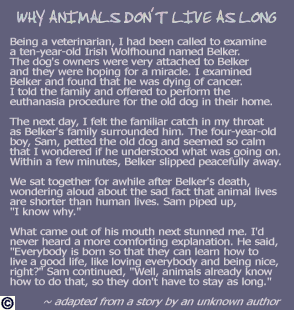
Ultimately, the last moment of bonding is probably as consoling for the chinparent as it is for the chin. If your chinchilla is nearing the end and you have the chance to speak with him before his spirit departs, tell him what Heaven will be like for chins:
“… A place with no cages, where all the chinchillas frolic happily on a superior replica of the Andes mountains. It’s always pleasantly cool with a soft breeze that circulates the scent of delectables served at the Road stop Raisin Lounges that dot the landscape: clear, cold water, a variety of fragrant hays, dried fruit, herbs, every tantalizing treat imaginable. And eat all you want, in Heaven, you won’t get the runs! Naturally, all the clouds are sprinkled with Blue Sparkle Dust for unlimited celestial dustbathing…” ~ The ChinCare webmasters and Lori E
Chincare’s Dedication
ChinCare is dedicated to the enduring memory of three exceptional chinchillas: Cervantes, Kavee, and Gwen. Shortly after their deaths, we decided to create a chinchilla care directory where chinparents could get answers from chinchilla care resources across the www. Perhaps if we’d had the same in our time of need, then we could have done more for our precious chinkiddies. In our hearts, we will always cherish these unforgettable lives that passed into the Elyssian Hay Fields before their time…
Cervantes lingered for six months after his neutering, never the same again in health or spirit until the angels finally took him. This was our first experience with neutering, with our first vet, who was an exotics specialist without prior experience in neutering chinchillas but we suspect the problem was that Cervantes had an allergic reaction to the anesthesia.
Our reason for surmising this is that when Cervantes’ son was neutered, he had a similar bit of wooziness, unbalance, almost retardation that thankfully passed after the first day of recovery. Since that first neutering we moved and changed vets and have had over two dozen successful neuterings with an exotics specialist vet who had experience in neutering chinchillas before we started seeing her (DVM Glikis-Scott, was Fernandez, of the Birmingham Veterinary Clinic in MI).
Kavee was brutally attacked by his cagemate and best friend after a third male was introduced and everyone seemed to be getting along. He died a few days later despite emergency vet care. From this experience, we learned something about the nature of chinchilla group interactions and cagemate conflicts, in particular, that males are more likely to get along for the long term if kept in groups of no more than two.
wen was killed on the same day the Twin Towers fell in NYC (09-01-01). Her neck was snapped when she attempted to jump off a 15″ wheel that had spokes on the sides. We put that wheel in the trash immediately and have been outspoken about wheel safety ever since.

